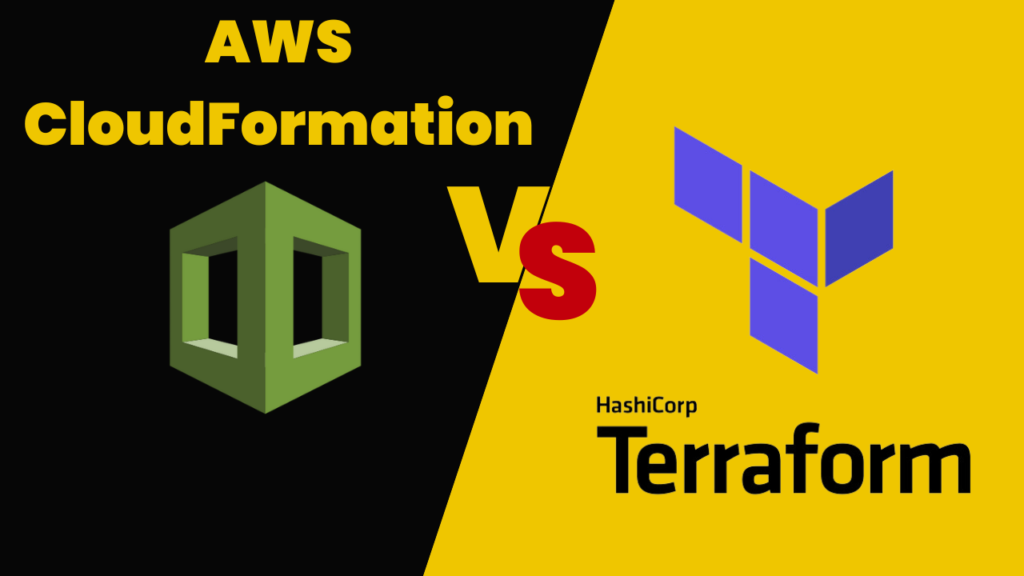Imagine building your own digital world in the cloud without much hassle. Well, you can! Two cool tools, AWS CloudFormation and Terraform, help make it happen. Let’s dive in and figure out which one suits you best!

Defining Infrastructure-as-Code (IaC)
Before diving into the comparison, let’s briefly recap the essence of Infrastructure-as-Code (IaC). IaC is a methodology that treats infrastructure as software, allowing it to be defined and managed using code. This approach brings a plethora of benefits, including:
- Consistency and Repeatability: IaC ensures consistent infrastructure deployment across different environments, eliminating manual errors and inconsistencies.
- Version Control: IaC templates can be version-controlled, enabling easy tracking of changes and rollbacks if necessary.
- Collaboration and Automation: IaC facilitates collaboration among team members and enables the automation of infrastructure provisioning and management tasks.
Comparing AWS CloudFormation and Terraform
To help you make an informed decision, let’s compare AWS CloudFormation and Terraform based on key aspects, let’s first talk about AWS CloudFormation:
AWS CloudFormation: The Native AWS IaC Solution
AWS CloudFormation is a native AWS IaC tool developed and maintained by Amazon. It utilizes a declarative approach, allowing users to define the desired state of their infrastructure using templates written in YAML or JSON. CloudFormation then takes care of creating, updating, or deleting resources to match the specified state.
Key Features of AWS CloudFormation:
- Deep integration with AWS services: CloudFormation offers seamless integration with a wide range of AWS services, providing native support for AWS-specific features and functionalities.
- Simplified deployment: CloudFormation simplifies infrastructure deployment by automating the process of creating and managing AWS resources, reducing manual intervention and minimizing errors.
- Cost optimization: CloudFormation can be used to enforce cost-saving policies, such as automatically terminating unused instances or selecting cost-effective resource configurations.
Real-world Scenario:
A software development team is tasked with deploying a new microservices-based application on AWS. They utilize CloudFormation templates to define the infrastructure components, including EC2 instances, load balancers, and databases. CloudFormation seamlessly handles the provisioning and configuration of these resources, ensuring consistent and reliable deployment.
Terraform: The Multi-Cloud IaC Powerhouse
Terraform is an open-source IaC tool developed by HashiCorp. It supports a wide range of cloud providers, including AWS, Azure, GCP, and others. Terraform uses a declarative approach similar to CloudFormation, defining the desired state of infrastructure using HashiCorp Configuration Language (HCL) templates.
Key Features of Terraform:
- Multi-cloud support: Terraform’s ability to manage infrastructure across multiple cloud providers makes it a versatile choice for organizations with a multi-cloud strategy.
- Modularity and reusability: Terraform promotes modularity and reusability through the concept of modules, which encapsulate reusable infrastructure configurations. This facilitates code reuse and streamlines complex deployments.
- Community support: Terraform boasts a vibrant community of users and contributors, providing extensive documentation, tutorials, and third-party modules.
Real-world Scenario:
A DevOps team manages a hybrid cloud environment, with some applications running on AWS and others on Azure. They leverage Terraform to provision and manage infrastructure resources across both cloud providers, ensuring consistent and standardized deployments.
Choosing the Right Tool: AWS CloudFormation vs. Terraform
The choice between AWS CloudFormation and Terraform depends on the specific requirements and goals of the organization.
AWS CloudFormation is a suitable choice for:
- Organizations primarily using AWS and seeking a native, tightly integrated IaC solution.
- Teams with limited experience in IaC, as CloudFormation offers a user-friendly interface and extensive documentation.
Terraform is a better fit for:
- Organizations with a multi-cloud strategy or considering adopting a multi-cloud approach.
- Experienced IaC users who value the flexibility and modularity offered by Terraform.
Both AWS CloudFormation and Terraform are powerful IaC tools that can significantly enhance cloud infrastructure management efficiency and consistency. The choice between the two depends on the specific needs and preferences of the organization. Carefully evaluate the requirements and consider the strengths and limitations of each tool before making a decision.
Thanks for reading! I hope you found this post helpful. If you have any questions, please leave a comment below or you can connect on below platforms (Youtube & telegram) for more “To The Point” Learning.
Telegram: https://t.me/t3pacademy & https://t.me/LearnDevOpsForFree
Youtube: https://www.youtube.com/@T3Ptech